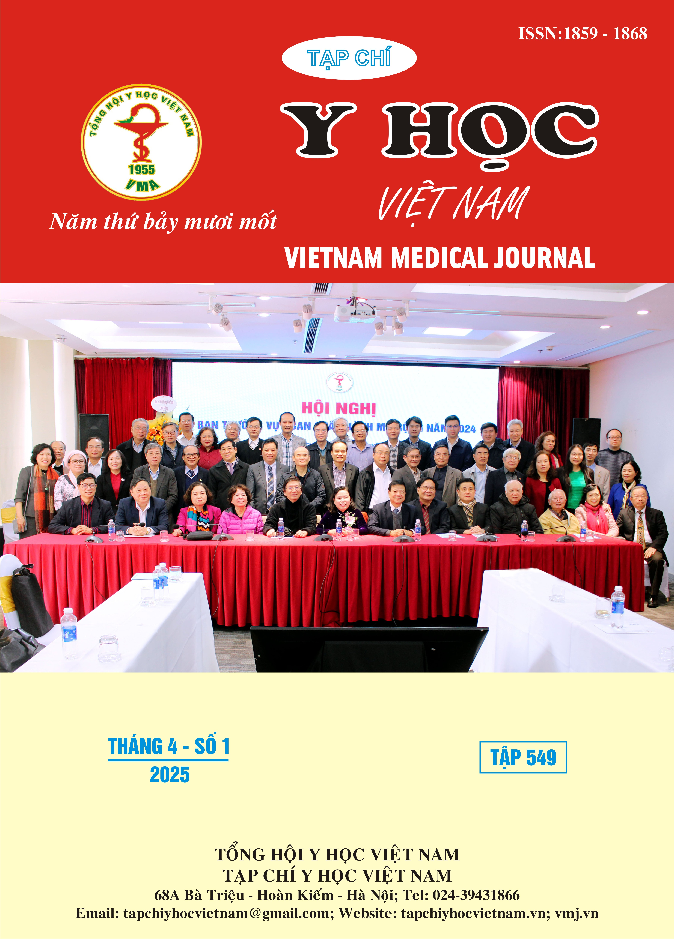SỰ THAY ĐỔI NỒNG ĐỘ HBCRAG TRONG QUÁ TRÌNH ĐIỀU TRỊ VIÊM GAN B MẠN TÍNH BẰNG THUỐC NUCLEOT(S)IDE VÀ MỐI TƯƠNG QUAN VỚI CÁC DẤU ẤN SINH HỌC
Nội dung chính của bài viết
Tóm tắt
HBcrAg- kháng nguyên liên quan đến lõi của virus bao gồm 3 protein được mã hóa bởi vùng lõi/tiền lõi là HBcAg, HBeAg và protein tiền lõi 22-kDa (p22cr). Những nghiên cứu gần đây cho thấy vai trò của HBcrAg trong lâm sàng: Có thể dự đoán chuyển đảo huyết thanh HBeAg tự nhiên hoặc do điều trị, khả năng tái hoạt động của vi rút viêm gan B (HBV), tái nhiễm HBV sau ghép gan và nguy cơ tiến triển hoặc tái phát ung thư biểu mô tế bào gan. HBcrAg có mối tương quan với HBV DNA trong huyết thanh và cccDNA trong gan. Đặc biệt, ở các trường hợp lâm sàng với HBV DNA huyết thanh không thể phát hiện được hoặc mất HBsAg, HBcrAg vẫn có thể được phát hiện và việc giảm nồng độ HBcrAg có liên quan đáng kể đến kết quả đầy hứa hẹn cho bệnh nhân viêm gan B mạn (CHB). Hiện tại, ở Việt Nam chưa có nhiều nghiên cứu về HBcrAg nên chúng tôi tiến hành đề tài: Sự thay đổi nồng độ HBcrAg trong quá trình điều trị viêm gan B mạn tính bằng thuốc nucleot(s)ide và mối tương quan với các dấu ấn sinh học, với hai mục tiêu: 1. Khảo sát nồng độ HBcrAg ở những bệnh nhân viêm gan B mạn tính đang điều trị thuốc ức chế vi rút nucleot(s)ide. 2. Đánh giá sự thay đổi nồng độ HBcrAg trong quá trình điều trị bệnh nhân viêm gan B mạn tính bằng thuốc nucleot(s)ide và mối tương quan với các dấu ấn sinh học. Đối tượng nghiên cứu: Bệnh nhân CHB ≥18 tuổi không có xơ gan đang điều trị thuốc kháng virus từ 2-4 năm có HBVDNA huyết thanh dưới ngưỡng phát hiện. Phương pháp nghiên cứu: Nghiên cứu tiến cứu, quan sát một loạt ca bệnh. Kết quả nghiên cứu: 325 bệnh nhân CHB đủ tiêu chuẩn vào nghiên cứu với đặc điểm: Nam: 56,6%, tuổi 30–50: 69,2% và HBeAg(+): 38,2%. Nồng độ trung bình HBcrAg ở nhóm HBeAg(+) là 5,56± 0,96, cao hơn nhóm HBeAg(-) (3,43± 1,10)(p<0,05), sự khác biệt về nồng độ HBcrAg giữa các nhóm tuổi có ý nghĩa thống kê trong khi không có sự khác biệt theo số năm điều trị NAs. Trong điều trị NAs, mặc dù HBV DNA về dưới ngưỡng phát hiện, nồng độ HBcrAg vẫn còn và tiếp tục giảm. Nồng độ HBcrAg tại thời điểm tuyển chọn, 6 và 12 tháng lần lượt là 4.791 logU/ml, 4.516logU/ml và 4.528 logU/ml (p=0,001), không có sự khác biệt giữa 2 nhóm HBeAg(+) và HBeAg(-). Nồng độ HBcrAg 4,95 log U/ml có giá trị tiên lượng chuyển đảo huyết thanh HBeAg với AUC = 0,672 (95% CI, 0,592-0,751), độ nhạy 81%, độ đặc hiệu 67% và PPV 57,1%, NPV 66,9%. Kết luận: Nồng độ HBcrAg có sự khác biệt giữa 2 nhóm HBeAg(-) và (+) và giữa các nhóm tuổi, tuy nhiên không có sự khác biệt giữa các nhóm có thời gian điều trị khác nhau. HBcrAg là dấu ấn hữu ích trong tiên lượng chuyển đảo huyết thanh HBe.
Chi tiết bài viết
Từ khóa
viêm gan B mạn tính, thuốc ức chế virus nucleot(s)ide, HBcrAg
Tài liệu tham khảo
2. N. T. C. Hồng, Đ. H. Long, H. T. K. Yến và et al, “Nghiên cứu các dấu ấn huyết thanh nhiễm HBV, mối tương quan giữa nồng độ HBsAg và tải lượng vi rút ở bệnh nhân viêm gan B mạn chưa điều trị tại bệnh viện trường đại học Y Dược Cần Thơ năm 2021-2022,” tạp chí y dược học Cần Thơ, tập 51, pp. 205-212, 2022.
3. W. Seto, D. Wong, J. Fung và et al, “Hepatitis B core-related antigen (HBcrAg) levels in the natural history of hepatitis B virus infection in a large European cohort predominantly infected with genotypes A and D,” Linearized hepatitis B surface antigen and hepatitis B core-related antigen in the natural history of chronic hepatitis B, tập 20, pp. 1173-1180, 2014.
4. P. T. Thuỳ và N. T. Vân Hồng, “Khảo sát sự thay đổi của HBCRAG trên bệnh nhân Viêm gan B mạn trước và sau điều trị TENOFOVIR DISOPROXIL FUMARATE 300MG,” Tạp chí y học Việt Nam, tập 521, số 1, 2023.
5. N. Itokawa, M. Atsukawa và et al, “Kinetics of the hepatitis B core-related antigen and treatment responses in chronic hepatitis B patients treated with tenofovir alafenamide,” Hepatology research, 2024.
6. Bộ Y tế và WHO, Phổ biến kết quả mô hình ước tính gánh nặng bệnh tật do viêm gan virus B, C và phân tích hiệu quả đầu tư., 2017.
7. N. Terrault, AASLD guidelines for treatment of chronic hepatitis B, Hepatology 2016, 63,261-283. [CrossRef] [pubmed]., 2016.
8. Liu F, Wang XW, Chen L và et al, “Systematic review with meta-analysis: Development of hepatocellular carcinoma in chronic hepatitis patients with hepatitis surface antigen seroclearance,” Aliment. pharmacol.Ther, tập 43, pp. 1253-1261, 2016.
9. L. V. Nam, “Nghiên cứu mối tương quan giữa tải lượng HBV DNA và hoạt độenzym ALT ởbệnh nhân viêm gan vi rút B mạn tính,” Tạp chí y học Việt Nam, tập 2, số 500, pp. 95-99, 2021.
10. B. Wang, I. Carey, M. Bruce và et al, “HBeAg seroconversion marks an important spontaneous change and treatment end-point for HBeAg-positive patients and is a pre-requisite for HBsAg loss or functional cure. In this retrospective analysis, we aimed to identify predictors of seroconversion usin,” J Viral Hepat ., tập 25, số 8, pp. 886-893, 2018.


